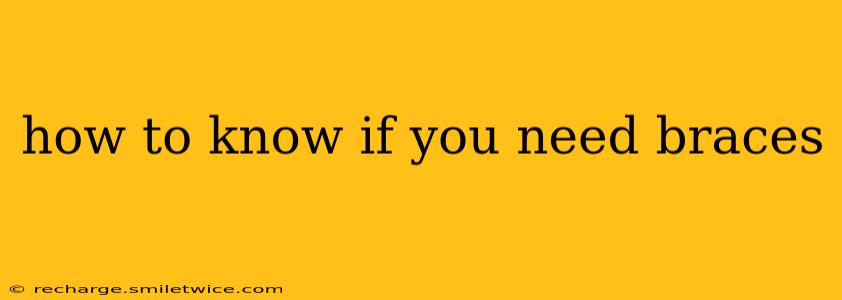Straight teeth are often associated with a confident smile, but the need for braces extends far beyond aesthetics. Malocclusion, or improper alignment of teeth and jaws, can lead to various oral health problems. This comprehensive guide will help you understand the signs that indicate you might need braces, dispelling common myths and offering clarity on when to seek professional orthodontic advice.
What are the signs I might need braces?
This is the most common question people ask when considering orthodontic treatment. Several factors indicate a potential need for braces. These include:
- Overcrowding: If your teeth are too crowded, they may overlap or become misaligned, making it difficult to clean effectively and increasing the risk of cavities and gum disease.
- Spacing: Gaps between your teeth, while sometimes considered aesthetically pleasing by some, can also lead to difficulties in chewing and speaking, and may indicate underlying issues.
- Crossbite: This occurs when the upper teeth fit inside the lower teeth, rather than overlapping them. It can impact chewing and jaw alignment.
- Underbite: An underbite is when the lower teeth protrude beyond the upper teeth. This can cause jaw pain and affect chewing function.
- Overbite: An overbite occurs when the upper teeth significantly overlap the lower teeth. Severe overbites can lead to jaw problems and difficulty chewing.
- Open bite: An open bite is when the front teeth don't meet when you bite down. This can interfere with chewing and speaking.
- Difficulty chewing or biting: If you consistently struggle to chew food properly or experience pain while biting, it could be a sign of misaligned teeth.
- Jaw pain or clicking: Persistent jaw pain or clicking sounds could indicate temporomandibular joint (TMJ) disorder, often linked to misaligned teeth.
- Difficulty speaking: In some cases, severely misaligned teeth can impact speech clarity.
- Increased risk of dental injury: Protruding teeth are more prone to damage from impacts.
What about cosmetic concerns? Do I need braces just for looks?
While aesthetics are a valid reason to consider braces, it's crucial to understand that orthodontics addresses both functional and cosmetic issues. Braces can improve your smile's appearance, boosting your confidence. However, the underlying health benefits should also be considered. A consultation with an orthodontist is the best way to determine if your cosmetic concerns are related to underlying functional problems that require treatment.
How can I tell if I need braces for my child?
Early intervention is key for children's orthodontic treatment. Parents should watch for signs of malocclusion early on and schedule a consultation with an orthodontist around the age of 7. Signs in children that may indicate a need for braces include:
- Early or late loss of baby teeth: This can indicate jaw development problems.
- Protruding or unusually positioned teeth: Noticeable misalignment of baby or permanent teeth.
- Difficulty chewing or biting: Similar to adults, children experiencing trouble chewing may need orthodontic intervention.
- Mouth breathing: This can contribute to facial development problems.
- Thumb sucking or pacifier use beyond age 4: Prolonged habits can affect teeth alignment.
At what age is it too late to get braces?
It's never too late to improve your smile and address functional issues! While many people get braces during adolescence, adult orthodontics is increasingly common. Adult patients may benefit from various orthodontic treatments to correct misalignment, improve oral health, and enhance their confidence.
How much do braces cost?
The cost of braces can vary depending on the complexity of the treatment, the type of braces (traditional metal, ceramic, Invisalign), and your location. It's best to schedule a consultation with an orthodontist to get a personalized quote and explore financing options.
What are the different types of braces available?
There's a range of brace types available, each with its advantages and disadvantages. These include traditional metal braces, clear ceramic braces, and Invisalign aligners. An orthodontist can help you determine the best option for your specific needs and preferences. They will consider factors such as your age, the severity of your malocclusion, and your lifestyle.
When should I schedule a consultation with an orthodontist?
If you have any concerns about your teeth or jaw alignment, it's advisable to schedule a consultation with an orthodontist. Early diagnosis and intervention can often lead to better treatment outcomes and prevent potential future complications. Don't hesitate to seek professional advice – your smile and overall oral health are worth it!
